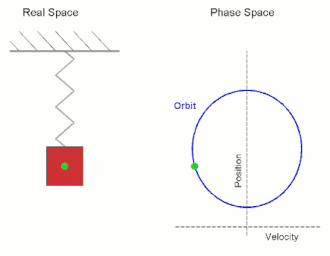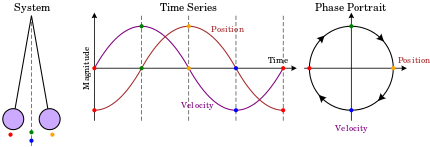Phase space

| Differential equations |
|---|
| Scope |
| Classification |
| Solution |
| People |
In
Principles
In a phase space, every degree of freedom or parameter of the system is represented as an axis of a multidimensional space; a one-dimensional system is called a phase line, while a two-dimensional system is called a phase plane. For every possible state of the system or allowed combination of values of the system's parameters, a point is included in the multidimensional space. The system's evolving state over time traces a path (a phase-space trajectory for the system) through the high-dimensional space. The phase-space trajectory represents the set of states compatible with starting from one particular initial condition, located in the full phase space that represents the set of states compatible with starting from any initial condition. As a whole, the phase diagram represents all that the system can be, and its shape can easily elucidate qualities of the system that might not be obvious otherwise. A phase space may contain a great number of dimensions. For instance, a gas containing many molecules may require a separate dimension for each particle's x, y and z positions and momenta (6 dimensions for an idealized monatomic gas), and for more complex molecular systems additional dimensions are required to describe vibrational modes of the molecular bonds, as well as spin around 3 axes. Phase spaces are easier to use when analyzing the behavior of mechanical systems restricted to motion around and along various axes of rotation or translation – e.g. in robotics, like analyzing the range of motion of a robotic arm or determining the optimal path to achieve a particular position/momentum result.
Conjugate momenta
In classical mechanics, any choice of
Statistical ensembles in phase space
The motion of an
In low dimensions
For simple systems, there may be as few as one or two degrees of freedom. One degree of freedom occurs when one has an autonomous ordinary differential equation in a single variable, with the resulting one-dimensional system being called a
The phase space of a two-dimensional system is called a phase plane, which occurs in classical mechanics for a single particle moving in one dimension, and where the two variables are position and velocity. In this case, a sketch of the phase portrait may give qualitative information about the dynamics of the system, such as the limit cycle of the Van der Pol oscillator shown in the diagram.
Here the horizontal axis gives the position, and vertical axis the velocity. As the system evolves, its state follows one of the lines (trajectories) on the phase diagram.

Related concepts
Phase plot
A plot of position and momentum variables as a function of time is sometimes called a phase plot or a phase diagram. However the latter expression, "phase diagram", is more usually reserved in the physical sciences for a diagram showing the various regions of stability of the thermodynamic phases of a chemical system, which consists of pressure, temperature, and composition.
Phase portrait

In
Phase portraits are an invaluable tool in studying dynamical systems. They consist of a
Phase integral
In classical statistical mechanics (continuous energies) the concept of phase space provides a classical analog to the
Applications


Chaos theory
Classic examples of phase diagrams from chaos theory are:
- the Lorenz attractor
- population growth (i.e. logistic map)
- parameter plane of complex quadratic polynomials with Mandelbrot set.
Quantum mechanics
In
But they may alternatively retain their classical interpretation, provided functions of them compose in novel algebraic ways (through Groenewold's 1946 star product). This is consistent with the uncertainty principle of quantum mechanics. Every quantum mechanical observable corresponds to a unique function or distribution on phase space, and conversely, as specified by Hermann Weyl (1927) and supplemented by John von Neumann (1931); Eugene Wigner (1932); and, in a grand synthesis, by H. J. Groenewold (1946). With
Expectation values in phase-space quantization are obtained isomorphically to tracing operator observables with the density matrix in Hilbert space: they are obtained by phase-space integrals of observables, with the
Thus, by expressing quantum mechanics in phase space (the same ambit as for classical mechanics), the
Classical expressions, observables, and operations (such as
Thermodynamics and statistical mechanics
In
The phase space can also refer to the space that is parameterized by the macroscopic states of the system, such as pressure, temperature, etc. For instance, one may view the pressure–volume diagram or temperature–entropy diagram as describing part of this phase space. A point in this phase space is correspondingly called a macrostate. There may easily be more than one microstate with the same macrostate. For example, for a fixed temperature, the system could have many dynamic configurations at the microscopic level. When used in this sense, a phase is a region of phase space where the system in question is in, for example, the liquid phase, or solid phase, etc.
Since there are many more microstates than macrostates, the phase space in the first sense is usually a manifold of much larger dimensions than in the second sense. Clearly, many more parameters are required to register every detail of the system down to the molecular or atomic scale than to simply specify, say, the temperature or the pressure of the system.
Optics
Phase space is extensively used in nonimaging optics,[5] the branch of optics devoted to illumination. It is also an important concept in Hamiltonian optics.
Medicine
In medicine and bioengineering, the phase space method is used to visualize multidimensional physiological responses.[6][7]
See also
- Configuration space (mathematics)
- Minisuperspace
- Phase line, 1-dimensional case
- Phase plane, 2-dimensional case
- Phase portrait
- Phase space method
- Parameter space
- Separatrix
- Applications
- Optical phase space
- State space (controls)for information about state space (similar to phase state) in control engineering.
- State spacefor information about state space with discrete states in computer science.
- Molecular dynamics
- Mathematics
- Cotangent bundle
- Dynamic system
- Symplectic manifold
- Wigner–Weyl transform
- Physics
- Classical mechanics
- Hamiltonian mechanics
- Lagrangian mechanics
- State space (physics)for information about state space in physics
- Phase-space formulation of quantum mechanics
- Characteristics in phase space of quantum mechanics
References
- S2CID 17205307.
- ISBN 0-521-84635-8.
- ^ Vu-Quoc, L. (2008). "Configuration integral". Archived from the original on April 28, 2012.
- S2CID 119230734.
- ISBN 978-1482206739.
- PMID 36979723.
- PMID 15183891.
Further reading
- Nolte, D. D. (2015). Introduction to Modern Dynamics: Chaos, Networks, Space and Time. Oxford University Press. ISBN 978-0-19-965703-2.
- Nolte, D. D. (2018). Galileo Unbound: A Path Across Life, the Universe and Everything. Oxford University Press. ISBN 978-0-19-880584-7.
External links
- "Phase space", Encyclopedia of Mathematics, EMS Press, 2001 [1994]


